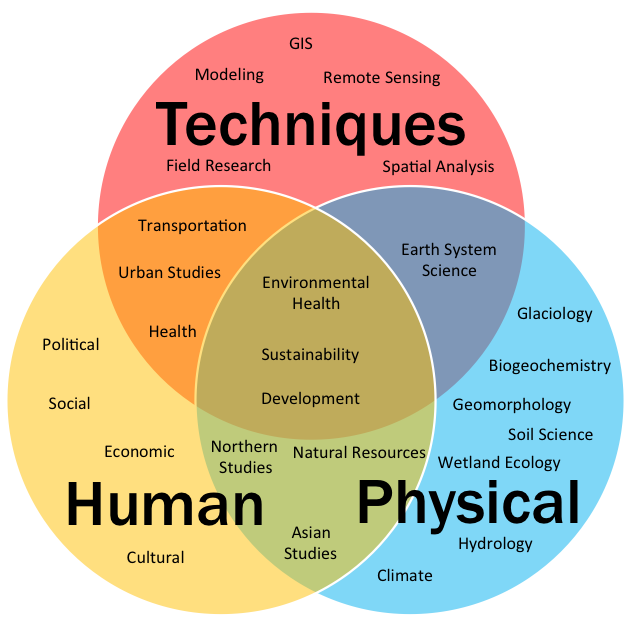Post 1: Up to the Starting Line
 |
| Interrelated components of geography: human geography, physical geography, and data techniques. |
According to Paul Knox and Sallie Marston, polls consistently show that Americans, particularly young people, lack geographic competency. One Gallup poll, for example, found that 70% of American young adults could not identify their own country on a map of the world! Even war has little positive effect -- in 2006, over 60% of young Americans could not accurately identify Iraq on a map of the Middle East.*
As a cultural anthropologist whose job it is to educate college students about the world and the people in it, these polls are astounding. In my opinion, it is impossible to fully appreciate cultural diversity or human cultural patterns without understanding the world we humans live in. Our lives are shaped by the places we live, just as the history of our species has been shaped by the environments we evolved in. Even more, our physical and cultural presence in the landscape also changes the environment. It is this relationship -- between people and the environment -- that we will study in this class. In a very practical sense, this class is a combination of my own field of expertise, cultural anthropology, with a field very much connected, and indebted, to it -- human geography.
This blog will function throughout the semester as a way for me to communicate course content directly with you, replacing in-person lectures. It will updated to give you information about readings and assignments.
This week's blog is aptly titled "Up to the Starting Line." This is the title of the first chapter in the Guns, Germs, and Steel and is also the focus of our first introductory week of classss. Please take some time this first week and familiarize yourself with the syllabus, the assignments, and Canvas.
One of our readings this week is a chapter from a Human Geography textbook written by Knox and Marsten. This reading will serve as a very basic introduction to geography, an introduction which will frame the rest of the course. Please pay particular attention to the definitions of human geography, place, identity, and interdependency. Please also read the inset "Making a Difference: The Power of Geography," which outlines some benefits of a geographic education and some of the jobs that geographers can do. We also begin to read Guns, Germs, and Steel and are introduced to the basic questions driving the book, In the Student Atlas, we learn some basic concepts about map-making and map-reading that we will use throughout the semester.
The class will get progressively more focused as we move through the semester. After this first week, it is divided into three discrete sections, with each section reflecting a different aspect of our major theme of people and the environment. The first section will focus on the role of the environment on cultural development. The second section will focus on the physical and cultural role of people on the environment. The third and final section will focus on the movement, or flow, of people and things across space and through environments.
Next week, we will begin to focus more narrowly on one of the major themes of this course -- the impact of the environment on human populations. We dive more deeply into Guns, Germs, and Steel and the Student Atlas. Check back then for Post 2!
*In Knox and Marston, Human Geography, Prentice Hall: New York, 2010.

Comments
Post a Comment